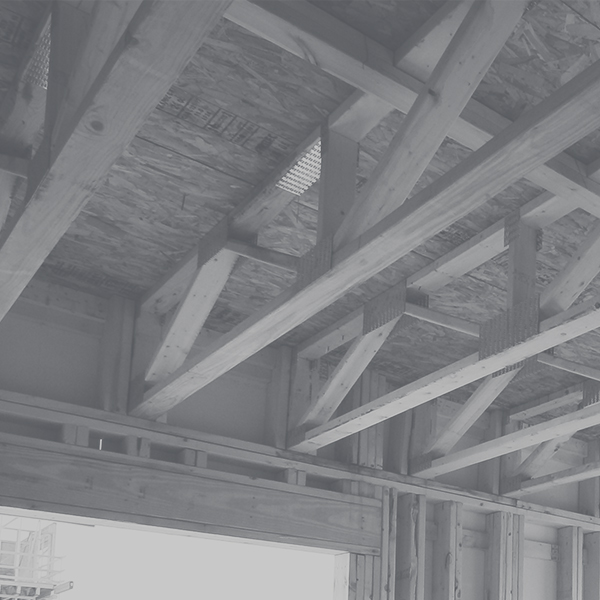Originally published in the February 2024 issue of STRUCTURE magazine
One of the more hotly debated topics in the multi-story wood community is whether wall stud and truss or joist alignment is required over the full height of a building, or whether it is beneficial to allow the framing to be unaligned. Let’s look at the advantages of each at a high level.
Aligned Bearing Wall Studs and Truss or Joist Framing
By aligning bearing wall studs with floor and roof trusses, we create a straightforward load path and eliminate the requirement for horizontal load transfer elements through the floor system depth. Alignment of studs also helps with coordination with other trades. Alignment of studs means alignment of spaces between studs, which allows plumbing stacks or conduit to run vertically throughout the height of the building without interfering with wall studs, floor framing, or load transfer elements.
Unaligned Bearing Wall Studs and Truss or Joist Framing
There are constructability benefits and efficiency gains in the design of the wall studs when allowing wall studs and floor and roof framing to be unaligned. From a constructability standpoint, there is more tolerance and flexibility in the field when alignment isn’t required. An unaligned approach could also allow for optimized stud spacing at any given level to accommodate accumulated loads.
Partially Aligned Bearing Wall Studs and Truss or Joist Framing
When we talk about alignment, there are two alignment elements to consider:
- Bearing wall stud alignment from floor to floor.
- Floor or roof framing alignment with the wall studs
Regardless of whether the bearing wall studs align from floor to floor, the reactions of the floor or roof framing must also have a load path to the bearing wall studs. In most situations, the trusses or joists bear on the double 2× top plates of the wall assembly below. It may be undesirable to align the wall studs with the floor framing. For example, wall studs may want to be at 16 inches o.c. to accommodate minimum spacing for exterior finishes, while floor joists may want to be at 24 inches o.c. to maximize floor sheathing capacity.
Which is the Preferred Approach?
Before we determine the best approach for our project, we need to know more about it.
- How many levels does the building have?
- What are the magnitudes of the floor framing reactions on the wall?
- Are we able to have a full-depth rim board as a load transfer element, and if so, are we limited to solid sawn lumber or can we use an engineered wood product?
- Are we able to have a ribbon board at the top of the floor truss as a load transfer element?
- Are there other limitations on wall stud spacing or truss spacing?
Once we determine the magnitude of the truss or joist reactions, the magnitude of the accumulated wall loads, and the potential span distance of load transfer elements, we can have a conversation with the framer and contractor about the feasibility, detailing, and cost implications of unaligned framing and the various methods at our disposal.
Can Double 2× Top Plates Be Used to Serve as Transfer Elements in an Unaligned Framing Condition in Multi-Story Construction?
As noted, the double 2× top plates in a conventional wall framing system are often used to transfer loads. If the reactions are small and the spans are short, it may be feasible for the double 2× top plates to resist concentrated loads (truss/joist reactions) as a transfer framing element. This common condition is not specifically addressed in the International Building Code, or the American Wood Council (AWC) National Design Specification, or other codes or referenced standards. But there are things to consider when trying to determine the capacity of double 2× plates:
- If using typical double-plate construction, do both plates act together as a composite member? If so, does adequate nailing between the two need to be provided for shear flow?
- If the plates are assumed to act independently of each other, what is the load distribution between them?
- How does the typical stagger/lap of plate elements impact the internal forces in either a composite or non-composite approach?
- Should this analysis assume both plates are simple spans for one stud bay? Should one of the plates be assumed continuous for several adjacent bays, or should both plates be continuous for several bays?
There are multiple methods of conducting this analysis that can produce significantly different results. Two of the analysis methods are presented here.
Method 1: Assume that the two plates are acting together as one composite 3-inch deep member. Although some engineers use this analysis method, it can be unconservative since nail slip and flexibility in wood connections aren’t easily considered in textbook shear flow calculations, which rely upon rigid connections between components (such as built-up steel W-shapes with welded connections).
Method 2: The consensus among many engineers is to assume that the two plates act independently, with the load distributed to each plate based on their stiffness. In other words, for common top plate construction, half the load goes to each plate.
As far as splice locations and looking at continuous vs. simple span members, there should be some offset in top plate splices to provide continuity in at least one top plate member. A simple span will produce the worst bending effects, and a continuous span will produce the worst shear effects. Enveloping the worst-case approach of both analyses allows for flexibility in wall framing construction.
The downside of using double 2× top plates as load transfer elements is that the capacity of the plates is low. A double 2 × 6 SPF (spruce, pine, fir) top plate spanning 16 inches between wall studs can only support a reaction of 1,000 to 1,400 lbs. when using the Method 2 approach. See Figure 4 for top plate testing. The AWC Wood Frame Construction Manual (WFCM) prescriptively limits floor joist spans to 26 ft. to specifically address this issue. The WFCM commentary to Section 3.1.3.2a states the following:
C3.1.3.2a Framing Member Spans. Framing member spans are limited to 26 feet for floors based on the bending capacity of the double top plates supporting floor framing members. The worst-case assumption is that a floor framing member bears directly between two studs, creating a concentrated load at mid-span of the top plates. Section 3.1.3.3g required band joists, blocking, or other methods to transfer roof, wall, and/or floor loads from upper stories to alleviate the concern of additional loads being transferred through the floor framing members into the top plate.
Higher Capacity Load Transfer Elements in an Unaligned Framing Condition
If the double 2× top plate does not have sufficient capacity to support the reaction of the truss/joist, it is possible to support the truss or joist on the full-depth rim board or girder truss first and then distribute loads to the top plates. The cost of the fasteners required to achieve this load path should be considered.
Method 1: Use full-depth rim boards. In this scenario, the stud above transfers loads to the bottom plate of the wall, through the floor sheathing, and into the full depth rim board. The rim board can then distribute loads to the top plate below, which then transfers loads to the unaligned studs.
Method 1A: Use a full-depth girder truss.
Method 2: Use a ribbon board at the top of the floor truss system (specific to parallel chord trusses). The ribbon board, often a 2 × 4 or 2 × 6 oriented vertically, flush top with the top of trusses, can be designed to collect loads from the studs above and transfer them directly to the end of the floor trusses to which they are attached. If the double top plate below the floor truss system is structurally adequate to support the reaction of the floor trusses (spanning between misaligned studs below if necessary), then nothing further is necessary. If the double top plate is not structurally adequate to support the truss reactions, then another ribbon board can be placed flush to the bottom of the trusses to redistribute the loads to the plates and studs.
Conclusions and Recommendations
The capacity of conventional double 2× top plates to serve as a load transfer element is often overlooked when designing multi-story light wood frame projects. The design process for bearing walls, as well as the detailing of floor-to-wall intersections, should consider whether higher capacity load transfer elements are required for unaligned construction or if defaulting to the alignment of studs with trusses or joists results in simpler construction.




